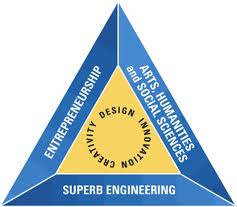Students today are operating in a space that is unfamiliar to college and university administrators and faculty. This space is a gap between the traditional university approach to education and the way Millennials learn, and it has deep implications for educators at all levels. At the college and university level, there needs to be a focus on addressing the following question: What is the role of colleges and universities in the 21st century in helping students achieve their goals to learn, to acquire knowledge and skills? At the K-12 level, the related question is: What is entailed to create a learning culture and to build learning platforms that fulfill the requirements of what school districts are mandated to teach and how students actually learn?
Students are experimenting with various ways to bridge this gap between the traditional university education and the real world skills that they need and desire. Students are proactively heralding in an era where they are self-teaching themselves through the Internet, extracurricular clubs, activities, and events. An example is how students who are interested in coding use events such as hackathons as a learning platform. (A hackathon is an event during which computer programmers and others in the field of software development collaborate intensively on software-related projects.) An earlier post commented:
On November 8-9, 2013 Yale hosted a hackathon called Y-Hack. The numbers associated with Y-Hack are as follows: approximately 1,000 participants from 80 schools; $20,000 in prizes; approximately 35 company sponsors (including Google, Microsoft, Goldman Sachs, Bloomberg LP, Bridgewater, Amazon Web Services, and Panorama Education). Y-Hack is an instance where students are active agents of academic capitalism because they are leveraging elements of Yale’s academic capitalist infrastructure to contemplate, design and create potential market ventures.
“We think Y-Hack is very aligned with President Salovey’s view for Yale,” stated one of the Y-Hack organizers. “With our hackathon,” he continued, “we want to inspire students to pursue these paths and to allow the already inspired students to create ventures. We challenge them to push each other and make the best products they can, and get rewarded for it. It’s rare to have so many intelligent and motivated minds from both the industrial and educational worlds together in one place with no other goal than to make something cool. It’s a pretty powerful atmosphere.” This commentary is in line with the message delivered by Yale President Salovey in his Inaugural Address: Our Educational Mission. He stressed a need for entrepreneurship at Yale. He wants to see the growth of student ventures: “We will also do more to nurture student entrepreneurs from every school and department.”
It is apparent to me now that the larger meaning for Yale of hosting Y-Hack is that students were filling the gap between what the university offers in traditional computer science education and how students learn to code. They were, moreover, engaging in a form of self-directed apprenticeship, marshalling university resources to facilitate an event where they could learn and experience coding in a high energy and interactive environment. One of the event organizers had the following observations about the larger meaning of Y-Hack: “It will be around after we graduate and continue to grow each year after that. With Y-Hack, students across the country have come to see Yale as an innovator in the technology, computer science, and engineering fields. And we are attempting to push [ourselves] further onto the world stage. We want to make sure that Yale students are actively contributing to and making a positive impact to the world by sharing their talents, creating value, and giving back to the community. It’s hard to predict how much impact Y-Hack could have, but we know for sure that it’s a move in the right direction.”
Y-Hack also attracted humanities students, a cohort that is not necessarily interested in technology related careers but have an interest in technology because they are in the generation of “digital natives.” There was an interesting article written about Yale’s hackathon, “YHackers: Behind the Scenes of Yale’s First Big Hackathon” by Nicole Clark, a rising junior in Pierson College. She described the impact that attending the event had on her as follows:
Despite their diversity of backgrounds and experiences, these leaders all seemed to think along the same lines. They knew about programming from learning on their own and going to hackathons. Not all of them were computer science majors. They told me that they were adapting to a rapidly evolving field by learning as they created. They didn’t just learn in the classroom, but used their own interests to fuel their creations. It was invigorating, as a student who is usually shunned out from these types of events, to be invited-even persuaded-to take part in the next hackathon.
Nicole does a wonderful job of capturing the essence of Y-Hack: an event intended for learning and experiencing coding in an intellectually intense and supportive environment. After this article appeared in the Yale Entrepreneur Magazine, a student-led publication, I asked her what she meant when she wrote about being shunned at technology oriented events. She explained that as an English major, she felt that Y-Hack was a welcoming environment for a non-technical person. Previously when she tried to get involved with [HackYale], a student-led organization for coders, she felt excluded because the application process to join [HackYale] requires technology proficiency.
Perhaps humanities students will be inspired by events like Y-Hack to raise their level of technological proficiency so that [HackYale] is an organic extension of their interest.









